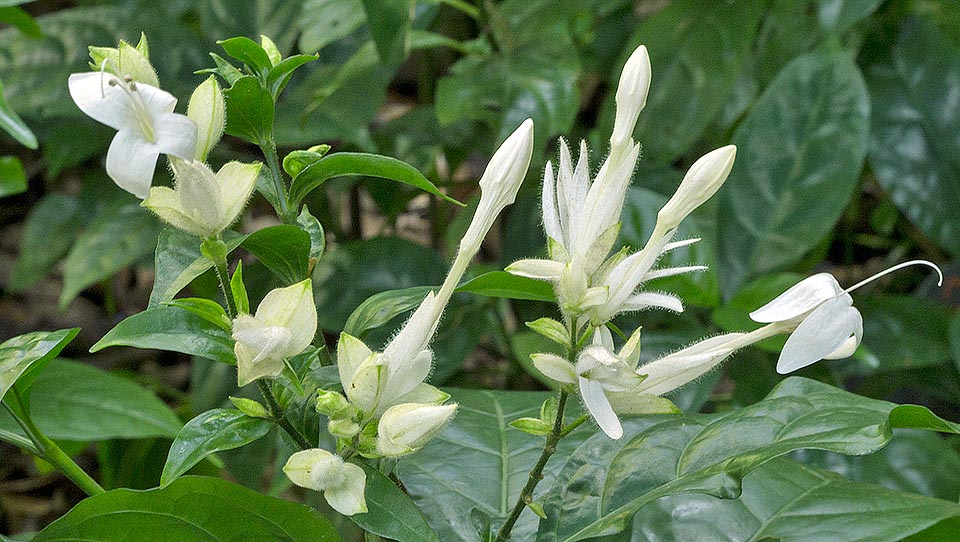Family : Acanthaceae

Text © Pietro Puccio

English translation by Mario Beltramini
The species is native to Angola, Cameroon, Central African Republic, Democratic Republic of the Congo, Equatorial Guinea, Ethiopia, Gabon, Ivory Coast, Kenya, Nigeria, Rwanda, Sudan, Tanzania and Zambia where it lives in the tropical forests often along the water streams, from the sea level up to about 1500 m of altitude.
The genus is honoured to the English botanist and collector Thomas Whitfield, who operated in Gambia and in Sierra Leone; the specific name is the Latin adjective “elongatus, a, um” = elongated, with reference to the long corolline tube.
Common names: white candles (English); indolou (Central African Republic); mbonyati (Tanzania).
The Whitfieldia elongata (P.Beauv.) De Wild. & T.Durand (1899) is an erect or sarmentose evergreen shrub, 2,5-6 m tall, with leaves, on a 1-3 cm long petiole, simple, opposite, elliptic with entire margin and pointe apex, 15-25 cm long and 4-10 cm broad, coriaceous, of dark green colour and glossy above. Cymose or panicle terminal inflorescences, one 1-4 cm long peduncle, 5-20 cm long, with green deciduous bracts, elliptic with pointed apex, 1,5 cm long.
Flowers, on a 1-6 mm long pedicel, with white tubular calyx, petaloideous, covered by short and thick down, 2-4 cm long, with five oblong lobes with pointed apex. The corolla is white with cylindrical corolline tube, thin, 3-6 cm long, imbutiform throat with 5 stretched or retroflexed lobes, elliptic, 1,8-2,8 cm long and 0,5-0,8 cm broad, and 4 prominent stamina, didynamous (2 longer and 2 shorter), with purple anthers.
The fruits are about 3 cm long capsules containing 2 globose seeds about 0,8 cm long. It propagates by seed, in organic acidic draining loam maintained humid at the temperature of 25-28 °C, and by cutting.

The Whitfieldia elongata is an erect or sarmentose evergreen shrub of tropical Africa. Abundant blooming in semi-shaded or shaded position. It adapts to the cultivation in pot for the decoration of winter gardens and inner spaces, with temperatures not under 14 °C and high humidity. Medicinal virtues for various pathologies © Giuseppe Mazza
Species diffused in a vast area of tropical Africa with candid blooming that lasts most of the year, cultivable in the zones with tropical and humid subtropical climate, not bearing temperatures close to 0 °C, if not exceptional and for very short period, on draining soils rich of organic substance, acidic, maintained almost constantly humid, but without stagnations.
It blooms abundantly in semi-shaded position as well as shaded, therefore can be employed as isolated specimen or for edges in gardens even if particularly shady where, as it is known, few are the utilizable floriferous species. Useful are periodical prunings for a more compact appearance and for stimulating the blooming; moreover, is capable to tolerate renewal prunings, even if drastic.
It adapts to the cultivation in pot for the decoration of greenhouses, winter gardens and inner spaces, with temperatures not under the 14 °C and high ambient humidity, that may be incremented, if the air is too dry, with frequent nebulizations with non calcareous water at ambient temperature or positioning the pot on a large diameter saucer filled with expanded clay or rubble partially covered by water, in way that the bottom does not get in contact with it. For the fertilizations, from spring to autumn, are to be utilized balanced products, with microelements in the forms of chelates, suitable for acidophilic plants.
Parts of the plant are variously utilized in the traditional medicine for various pathologies.
Synonyms: Ruellia elongata P.Beauv. (1805); Ruellia longiflora Nees (1847); Whitfieldia longifolia T.Anderson (1864); Whitfieldia longiflora S.Moore (1880); Whitfieldia perglabra C.B. Clarke (1899); Whitfieldia subviridis C.B. Clarke (1899); Whitfieldia tanganyikensis C.B. Clarke (1899); Whitfieldia longifolia var. perglabra (C.B. Clarke) Hutch. & Dalziel (1931).
